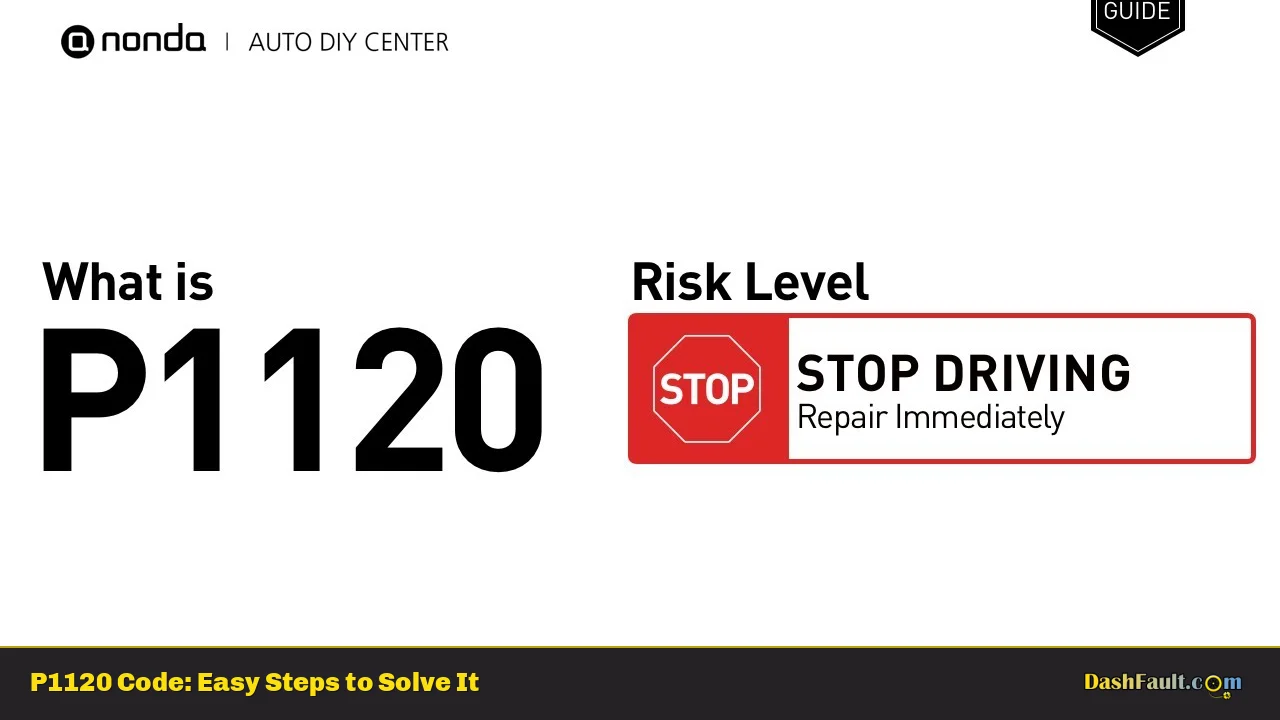The P1120 trouble code is a diagnostic trouble code (DTC) that indicates a problem with the throttle position sensor (TPS). Specifically, it signifies that the throttle position sensor’s input does not match what the vehicle’s powertrain control module (PCM) expects. This discrepancy can lead to various performance issues, including erratic engine behavior and poor acceleration. Understanding this code is crucial for vehicle owners and DIY mechanics, as it can help diagnose underlying problems and prevent more severe engine issues.
| P1120 Code Meaning | P1120 Code Common Causes |
|---|---|
| Throttle Position Sensor Out of Range | Faulty throttle position sensor |
| Low voltage signal from TPS | Damaged or corroded wiring or connectors |
| Signal mismatch between TPS and PCM | Faulty PCM or electronic control unit (ECU) |
| Throttle body malfunction | Electrical interference from aftermarket components |
| Calibration issues after part replacement | Improper installation of TPS or throttle body |
Symptoms of P1120 Code
When the P1120 code is triggered, drivers may experience several symptoms, including:
- Erratic Engine Performance: The vehicle may hesitate or experience sudden power loss.
- High Idle: The engine may idle at a higher RPM than normal, indicating a potential issue with throttle control.
- Transmission Problems: Difficulty in shifting gears or harsh shifting may occur due to the PCM limiting engine performance.
- Check Engine Light: The most obvious symptom is the illumination of the check engine light on the dashboard.
Understanding these symptoms can help vehicle owners identify when to investigate further or seek professional assistance.
Detailed Diagnosis for P1120 Code
Technical Explanations
The throttle position sensor is a critical component in modern vehicles that monitors the position of the throttle plate. This information is essential for the PCM to regulate fuel delivery and manage engine performance. When the TPS fails or sends incorrect signals, it can disrupt this balance, leading to the P1120 code.
Step-by-Step Diagnosis
- Scan for Codes: Use an OBD-II scanner to confirm the presence of the P1120 code and check for any additional codes that may provide further insight into the issue.
- Inspect Wiring and Connectors:
- Check for frayed wires or corrosion on connectors related to the TPS.
- Ensure all connections are secure and free from moisture.
- Test Throttle Position Sensor:
- Use a multimeter to measure voltage output from the TPS while manually moving the throttle plate.
- The voltage should change smoothly as you open and close the throttle. If it shows erratic readings, the sensor may be faulty.
- Check PCM Functionality:
- If the TPS appears functional, inspect the PCM for potential issues. This may require specialized diagnostic tools.
- Examine Throttle Body:
- Inspect for any obstructions or mechanical failures in the throttle body that could affect sensor readings.
Solution Methods
- Replace Throttle Position Sensor: If testing indicates that the TPS is faulty, replacing it is often necessary. Ensure you use a quality part compatible with your vehicle’s make and model.
- Repair Wiring Issues: If damaged wiring or corroded connectors are found, repair or replace them as needed.
- Recalibrate After Replacement: After replacing any components, ensure they are calibrated correctly according to manufacturer specifications.
Cost Estimates
- Throttle Position Sensor Replacement: Typically ranges from $50 to $300 depending on vehicle make and labor costs.
- Wiring Repairs: Costs can vary widely based on damage but generally range from $100 to $500 depending on accessibility and parts needed.
- PCM Replacement: If necessary, replacing a PCM can be significantly more expensive, often ranging from $500 to $1,500 including programming costs.
Warnings and Recommendations
Important: Always disconnect the battery before working on electrical components to avoid short circuits or damage to sensitive electronics.
If you are not comfortable performing these diagnostics or repairs yourself, it is highly recommended to seek assistance from a qualified mechanic. Ignoring a P1120 code can lead to more severe engine problems over time.
Closing Paragraph
The P1120 trouble code signifies an issue with your vehicle’s throttle position sensor, which plays a crucial role in engine performance. By understanding its meaning, symptoms, and how to diagnose it effectively, vehicle owners can take proactive steps in addressing potential problems before they escalate. Whether you’re a DIY mechanic or just looking for information about your vehicle’s health, being informed about DTCs like P1120 can save time and money in repairs while ensuring your vehicle runs smoothly.
Frequently Asked Questions About P1120
- What does P1120 mean?
The P1120 code indicates that there is an issue with the throttle position sensor, specifically that its signal is out of range. - What symptoms should I look for?
Common symptoms include erratic engine performance, high idle speeds, transmission shifting issues, and an illuminated check engine light. - Can I drive my car with a P1120 code?
It is not advisable to drive with this code as it can lead to reduced power and further damage if left unaddressed. - How do I fix a P1120 code?
The solution typically involves inspecting and possibly replacing the throttle position sensor or repairing any related wiring issues. - Is replacing a throttle position sensor difficult?
Replacing a TPS is generally straightforward but requires some mechanical knowledge; if unsure, consult a professional. - What tools do I need to diagnose a P1120 code?
A basic OBD-II scanner and multimeter are essential tools for diagnosing this trouble code. - Can other issues cause a P1120 code?
Yes, wiring problems, PCM failures, or even issues with other sensors can trigger this code. - How much does it cost to fix a P1120?
The cost varies widely depending on whether you need just a new sensor or more extensive repairs; expect costs between $50 and $1,500.
